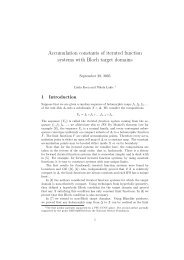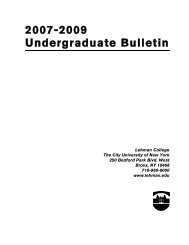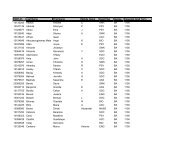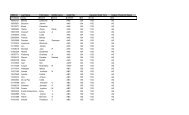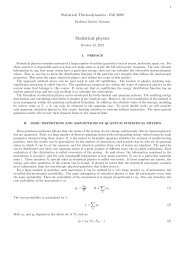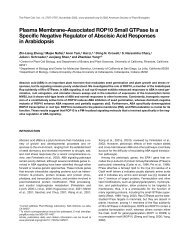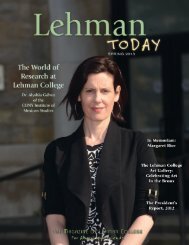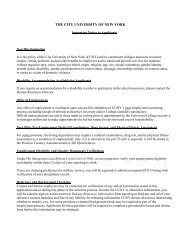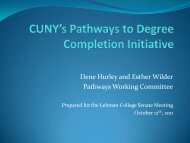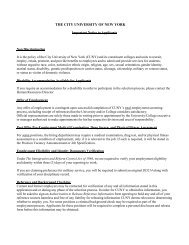You also want an ePaper? Increase the reach of your titles
YUMPU automatically turns print PDFs into web optimized ePapers that Google loves.
Originally, construction was conceived on a far grander scale. In<br />
1927, plans were drawn up for a series of Greek-inspired temples,<br />
complete with Doric columns, designed by architects John Russell<br />
Pope and Dwight James Baum; additional blueprints were soon<br />
created for a cultural center and a Museum of Peaceful Arts. The<br />
1929 Stock Market Crash and its aftermath, however, forced the<br />
City to abandon that vision. Instead, the four original buildings that<br />
stand to this day were created, designed by Charles B. Myers of<br />
the architectural firm of Thompson, Holmes & Converse.<br />
The Early Years<br />
A major project of those early years was the establishment of<br />
the Lehnerts Rock Garden, named after the faculty member who<br />
formed the Hunter Geology Department. Initiated in 1936 and<br />
York Times<br />
reporter covering the sessions called the campus “the<br />
diplomatic center of the universe,” as crises were handled in Iran,<br />
Greece, Spain, Indonesia, Syria, and Lebanon.<br />
Two months later, on a lovely autumn day in October, students returned.<br />
This Class of 1950 was the first to include male veterans—<br />
in 1951, the campus would officially become coeducational, and by<br />
1957 men would outnumber women for day classes. For most students,<br />
the green lawns were a welcome sight for their war-weary<br />
eyes. “It was a delight for us all, students and staff, to walk across<br />
the campus,” recalled Anne Trinsey, former dean of Hunter’s Bronx<br />
Division and an English professor. Her memories were recorded<br />
in the 1980s for a series of oral interviews directed by Professor<br />
Gary Schwartz and Eileen Ourvan of the <strong>Lehman</strong> Scholars Program.<br />
“The Navy and the Security Council had employed gardeners<br />
to keep all the campus acreage in good trim.”<br />
The campus, pre-1955. The tents<br />
belonged to an Army unit that<br />
guarded the reservoir in the 1950s<br />
during the Cold War.<br />
opened on May 29, 1940, this outdoor geological laboratory<br />
was located immediately north of Gillet Hall. It housed close to<br />
200 specimens of rocks and minerals from around the world,<br />
was crossed with flagstone paths, and featured benches for<br />
relaxing—themselves made of rock—as well as a pond stocked<br />
with goldfish, turtles, and a variety of plants.<br />
Not all the early years were taken up with academics. During<br />
World War II, students vacated the campus to make room<br />
for the WAVES (Women Accepted for Voluntary Emergency<br />
Service), a new branch of the military created by President<br />
Franklin D. Roosevelt. During their tenure on campus, the U.S.<br />
Navy trained more than 80,000 servicewomen as mechanics,<br />
decoders, and navigators, among other crucial wartime jobs.<br />
With the war over, the nascent United Nations took over the<br />
campus from March through August 1946, holding twentysix<br />
sessions of the Security Council and the Economic and<br />
Social Council in what is now the Old Gym Building. A New<br />
Ce<br />
C<br />
• •<br />
On<br />
O<br />
el<br />
Leh<br />
Le<br />
L<br />
le<br />
hma<br />
hm<br />
ebr<br />
eb<br />
an’s Hi<br />
an<br />
rat<br />
ra<br />
in<br />
ti<br />
ng<br />
H<br />
s<br />
Hi<br />
His<br />
s<br />
80<br />
8<br />
80<br />
to<br />
st<br />
Ye<br />
ic<br />
Y<br />
ri<br />
tor<br />
ea<br />
ar<br />
amp<br />
am<br />
Ca<br />
C<br />
rs<br />
pus<br />
pu<br />
“I started at Hunter <strong>College</strong> on Park Avenue as an<br />
adjunct in 1956. I taught in various places, but by 1964<br />
I was hired in the History Department at Hunter-in-the-<br />
Bronx. I taught urban history, early American history, and<br />
Colonial history. In 1967, when the faculty had to make<br />
a decision—did we want to go down to Park Avenue or<br />
did we want to stay in the Bronx?—the History Department,<br />
all five of us, decided to stay here in the Bronx.<br />
We liked it here. It was a totally different period at the campus, which was<br />
really quite nice. We had a good student body at <strong>Lehman</strong>. They were quite<br />
dedicated and always came to class prepared in those days. That changed<br />
over time. But I always remember in those years how much students<br />
wanted to learn. I remember talking about it with a colleague of mine [Dean<br />
Ratner] who said, recalling those early <strong>Lehman</strong> students, ‘They came to<br />
class hungry.’”<br />
— <strong>Lehman</strong> Professor of History Emeritus Jacob Judd<br />
(pictured with his wife, Irene)<br />
<strong>Lehman</strong> Today/<strong>Spring</strong> <strong>2011</strong> 233



